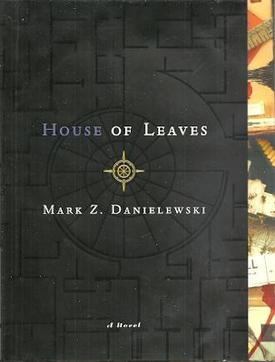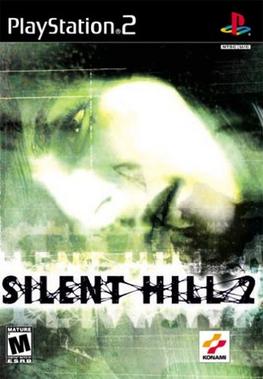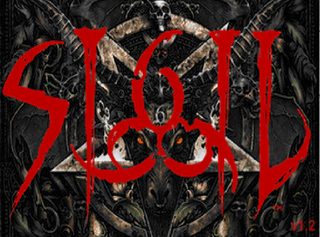
Doom is a first-person shooter game developed and published by id Software. Released on December 10, 1993, for DOS, it is the first installment in the Doom franchise. The player assumes the role of a space marine, later unofficially referred to as Doomguy, fighting through hordes of undead humans and invading demons. The game begins on the moons of Mars and finishes in hell, with the player traversing each level to find its exit or defeat its final boss. It is an early example of 3D graphics in video games, and has enemies and objects as 2D images, a technique sometimes referred to as 2.5D graphics.

Mark Z. Danielewski is an American fiction author. He is most widely known for his debut novel House of Leaves (2000), which won the New York Public Library's Young Lions Fiction Award. His second novel, Only Revolutions (2006), was nominated for the National Book Award.

House of Leaves is the debut novel by American author Mark Z. Danielewski, published in March 2000 by Pantheon Books. A bestseller, it has been translated into a number of languages, and is followed by a companion piece, The Whalestoe Letters.
Video game modding is the process of alteration by players or fans of one or more aspects of a video game, such as how it looks or behaves, and is a sub-discipline of general modding. Mods may range from small changes and tweaks to complete overhauls, and can extend the replay value and interest of the game.

TeamTNT was a distributed group of Doom mappers, originally formed as a Doom mailing list in 1994. The team are known for creating the TNT: Evilution episode of Final Doom, as well as several free level packs and developer resources for Doom II. Their source ports, the BOOM and Boom-DM engines were used by many level designers during the height of Doom modding in the 1990s. The group was largely inactive from 2008, with their resources remaining online until the 2015 death of administrator Ty Halderman.
Doom WAD is the default format of package files for the video game Doom and its sequel Doom II: Hell on Earth, that contain sprites, levels, and game data. WAD stands for Where's All the Data? Immediately after its release in 1993, Doom attracted a sizeable following of players who created their own mods for WAD files—packages containing new levels or graphics—and played a vital part in spawning the mod-making culture which is now commonplace for first-person shooter games. Thousands of WADs have been created for Doom, ranging from single custom levels to full original games; most of these can be freely downloaded over the Internet. Several WADs have also been released commercially, and for some people the WAD-making hobby became a gateway to a professional career as a level designer.

Doom 3: Resurrection of Evil is a survival horror first-person shooter video game developed by Nerve Software and published by Activision. It was released for Microsoft Windows worldwide on April 4, 2005, as an expansion pack and sequel to Doom 3 and on October 5, 2005, for the Xbox video game console. The Xbox version does not require the original Doom 3 in order to play, and includes The Ultimate Doom, Doom II: Hell on Earth and Master Levels for Doom II.

Final Doom is a first-person shooter video game developed by TeamTNT, and Dario and Milo Casali, and was released by id Software and distributed by GT Interactive in 1996. It was released for MS-DOS and Macintosh computers, as well as for the PlayStation, although the latter featured a selection of levels from Final Doom and from Master Levels for Doom II.

Silent Hill 2 is a 2001 survival horror game developed by Team Silent, a group in Konami Computer Entertainment Tokyo, and published by Konami. The game was released from September to November, originally for the PlayStation 2. The second installment in the Silent Hill series, Silent Hill 2 centers on James Sunderland, a widower who journeys to the town of Silent Hill after receiving a letter from his dead wife. An extended version containing an extra bonus scenario, Born from a Wish, and other additions was published for Xbox in December of the same year. In 2002, it was ported to Microsoft Windows and re-released for the PlayStation 2 as a Greatest Hits version, which includes all bonus content from the Xbox port. A remastered high-definition version was released for the PlayStation 3 and Xbox 360 in 2012 as part of the Silent Hill HD Collection.

Doom is a 2016 first-person shooter video game developed by id Software and published by Bethesda Softworks. The game is the first major installment in the Doom series since 2004's Doom 3 and was a reboot of the franchise. It was released for PlayStation 4, Windows, and Xbox One in May 2016. A port for Nintendo Switch was co-developed with Panic Button and released in November 2017, and a version for Google Stadia was released in August 2020. Players take the role of an unnamed space marine, known as the "Doom Slayer", as he battles demonic forces within an energy-mining facility on Mars and in Hell.
Goosebumps HorrorLand is a horror novella series by R.L. Stine, a spin-off of his popular Goosebumps books. There was an almost ten-year gap between the publication of the initial installment in the Goosebumps Horrorland.

Cyriak Harris, known mononymously as Cyriak, his B3ta username Mutated Monty, and Mouldy in the Doom community, is an English freelance animator, artist, composer, and author from Brighton. He is known for his surreal and bizarre short web animations with the frequent use of the Droste effect. Cyriak is his real birth name.
Brutal Doom is a game mod for the 1993 first-person shooter Doom created by the Brazilian developer Marcos "Sergeant Mark IV" Abenante. It adds numerous gameplay elements and graphical effects. The mod has been in development since 2010, and continues to release new updates.

Sonic Robo Blast 2 is a platform game made within id Software's Doom engine. It is a free Sonic the Hedgehog fan game inspired by the original Sega Genesis games that "attempts to recreate their design in 3D", and was the first fan-made 3D Sonic game created. The game has received consistent support throughout its development of over 20 years, which has been attributed to a large modding community.

The Cacowards are an annual online awards ceremony which honors the year's most prominent "Doom WADs", video game modifications of the 1993 first-person shooter Doom. Such modifications may be single levels, level packs, or "total conversions" featuring gameplay that significantly diverges from traditional Doom. Although generally focusing on classic Doom games, modifications for other Doom-engine based games such as Heretic, Hexen and Strife have also been featured. Since 2004, the Cacowards have been hosted at doomworld.com, a Doom fansite.

Grezzo 2 is a first-person shooter video game developed by Italian game designer Nicola Piro and released in 2012. The game is a total conversion modification of the 1993 video game Doom and its development began in the early 2000s, with the version called Grezzo 1, when Nicola Piro attended high school.

"The Most Mysterious Song on the Internet" is the nickname given to a cassette recording of an unidentified song, most likely composed in the 1980s.

Sigil is the unofficial fifth episode of the 1993 video game Doom. Published by Romero Games on May 31, 2019, the Megawad was created by an original co-creator of Doom, John Romero, independently of the main game's then-current owner, Bethesda Softworks. It has nine missions, each with a deathmatch version, and a new soundtrack created by James Paddock and Buckethead. While initially released independently, Bethesda later released the episode as a patch for the console ports of Doom.
Bloom is a mod for id Software's video game Doom II. It is designed to merge all of the enemies, weapons and environment elements of Monolith Productions' Blood and Doom II, creating a crossover of both game universes. It was developed by Spanish indie studio Bloom Team and released via Mod DB on October 31, 2021.














